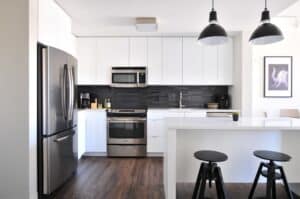Designing a new kitchen in your home is an exciting time, with a wealth of important decisions to be made. But before you get carried away with the style of kitchen cabinets, the colour scheme, choice of worktops, flooring, and appliances, don’t forget one of the key fundamentals for any design scheme.
Kitchen lighting is often overlooked or simply added on as an afterthought. However, get it wrong and you’ll be kicking yourself for years. Get it right and you’ll benefit from a bright, friendly and more efficient space that you will love to spend time in.

In the beginning, there was light
It’s tempting to disregard light as something that’s just there, without paying any attention to the quality of the illumination provided. Did you know that light is a natural space enhancer that can make any room feel bigger and brighter? When it comes to planning a lighting scheme for your new kitchen, it would be a mistake not to take full advantage of all the tricks available, and allocate an adequate budget towards it.
Consider lighting as one of the first elements of your new kitchen design and take your time to get it right to avoid costly mistakes. Don’t forget that electrics and light fittings will need to be installed before any plastering, decorating and kitchen fitting can happen. Rectifying errors afterwards can be both messy and expensive.
A good starting point is the amount of natural light that comes into the room. How bright is the room? How does the light change during different times of the day, and through the seasons? Maximising daylight should be balanced with an artificial lighting scheme to get the optimum result for the space.

Consider each kitchen zone
Divide your kitchen area into discrete zones for the purposes of lighting. Food preparation, cooking and cleaning areas will need strong directional and functional ‘task lighting’ in addition to general ambient light.
You may wish to highlight certain kitchen spots, architectural features or artwork with feature lighting, or install dimmers for a more relaxed atmosphere. Think of different types of lighting to serve different functions, and aim to create an overall layered lighting scheme to give you the most options.
Don’t forget to take into account kitchen surfaces too. Some materials such as glass or stainless steel splashbacks, polished granite worktops or high gloss kitchen cabinets can help to bounce light around the room, with the effect of increasing the amount of light in your kitchen.
Types of lighting
Task light requirements should be addressed first. Is there enough light brightening up workspaces to carry out all tasks safely and comfortably? Food preparation areas such as worktops, sinks and cooking areas will need a direct light that won’t throw shadows. Unlike exposed light fittings, recessed or semi-recessed fittings will be less exposed to kitchen grease and grime, so may be worth a consideration. Alternatively, under-cabinet lighting spaced approx. 50cm apart are a great solution, especially if you use energy-saving LEDs. Direct light over kitchen cabinets and drawers may help you find crockery and cooking utensils more easily. For great task lighting ideas, I recommend Light Supplier!
Decorative lights are a wonderful way to feature your favourite pieces. Lighting can be put in glass cabinets or behind shelves to showcase your favourite objects or collection of recipe books. For a dramatic look, add lighting strips to plinths and kickplates for an after-dark ‘wow’ factor.
Dedicated dining lights are a must for dining areas or breakfast bars. But it’s not enough to simply illuminate the food on the table, you will need a softer light for after-dinner socialising too. Combine overhead pendant lights with table lamps or wall lights to create a soft, warm ambience.
Mood lighting is particularly important in open-plan, multifunctional spaces such as kitchen diners. You need a lighting solution to be able to go from a functional, practical space while food is being prepared to a relaxing area for entertaining and relaxing at other times of the day or night. A layered lighting scheme is invaluable for creating the right atmosphere for different types of activity. And don’t shy away from using colour-changing LEDs for extra impact.

Set the stage
It helps to think of your kitchen as a stage set, with flexible lighting scheme options available to create different effects, depending on the time of day, the task at hand, and the mood you want to create. Before you make a decision, look at the room from various angles, and the lighting conditions and requirements in the morning, at lunchtime, in the afternoon and in the evening.
Consider all the features in the room and choose what you want to highlight and what should stay in the background. Use a combination of uplighters and downlighters, spotlights, shelf lighting and accent lights.
Luckily, lighting technology is developing apace, putting a wider and more advanced range of choices within budget reach. Consult your electrician and kitchen fitter at every point of the decision-making so that everyone is kept in the loop of what’s happening where and when.
Design and installation advice
If you’re using a kitchen design company, talk through your thoughts and requirements and get expert advice on which solutions would work best. Specialist companies such as The Brighton Kitchen Company have a vast amount of product and design knowledge and can offer valuable inspiration and guidance to get you the result you’re after.
It should go without saying that only a qualified electrician should be consulted for advice, and instructed to carry out any electrical work in your kitchen. This includes any new sockets, lighting fixtures, cookers, cooker hoods and any other electrical items you wish to install.
Government legislation stipulates that all electrical work must be undertaken by a qualified person who should supply you with a certificate to show that all work has been tested and complies with Part P of the Building Regulations. Kitchens are considered ‘special’ areas because of the proximity of water to electrical sockets.































